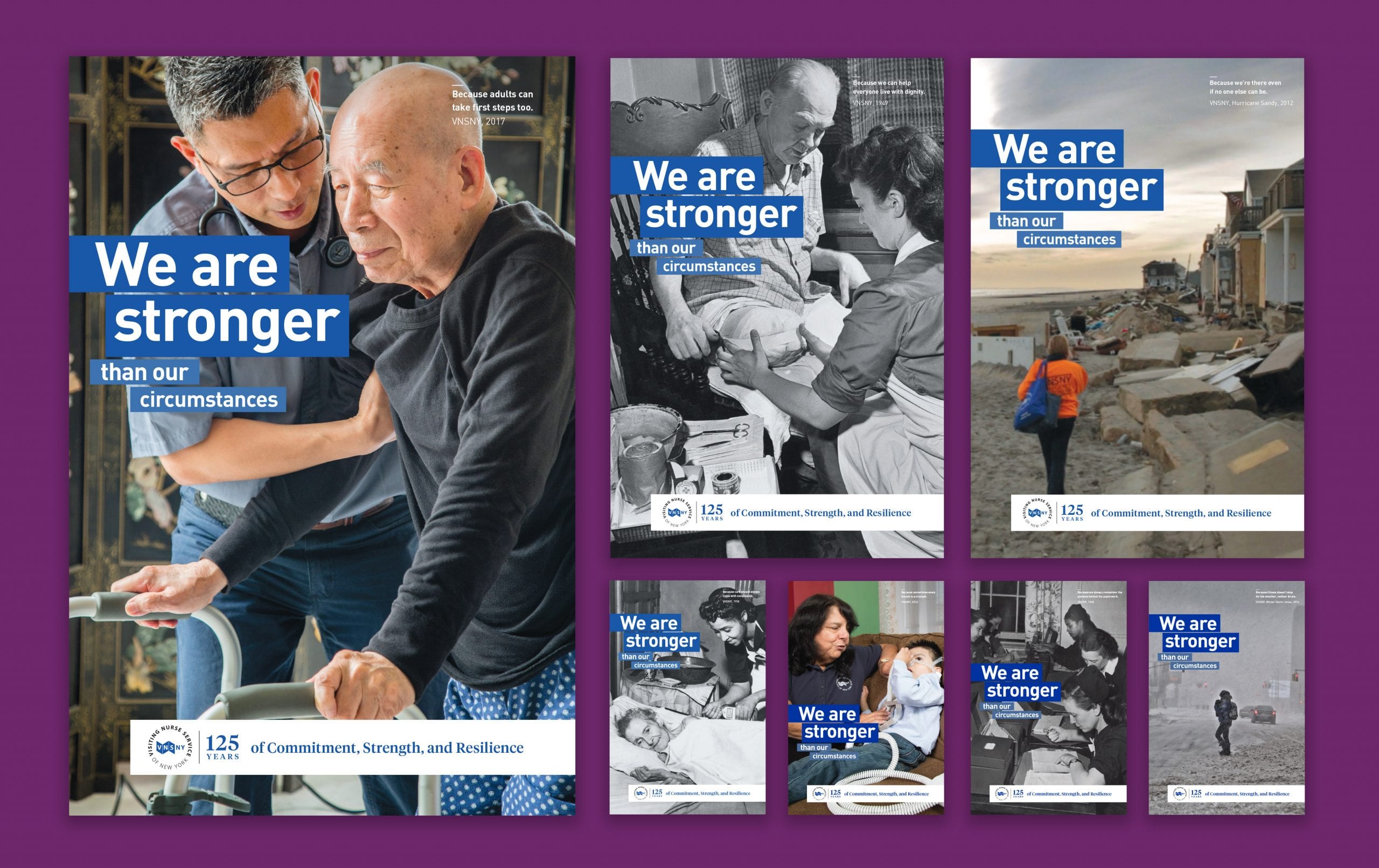Written in collaboration with Therese Nguyen
If you’ve ever watched a hospital commercial or seen an ad for a healthcare provider, you might have felt that they all seem to blend together. The same heartfelt music, comforting visuals, and identical messages of care and trust. Remove the logos, and it’s often impossible to tell one brand from another.
This is the “sea of sameness” that doctor and hospital marketing regularly finds itself in—a space where creativity and differentiation are overlooked in favor of campaigns that feel safe but are also forgettable.

In an industry that’s as competitive as healthcare, blending in should not be the objective. While marketing for doctors and hospitals is undoubtedly different from other industries, it doesn’t have to be boring or repetitive. With a clear strategic foundation and energetic, creative problem-solving that is willing to break away from well-established patterns, hospitals and healthcare providers can find ways to stand out. In advertising, getting noticed is job one because if you cannot accomplish that, none of the rest matters.
The problem with looking alike
When all healthcare advertising looks the same, it creates more problems than just visual monotony. It can directly impact a brand’s ability to attract and retain patients. Here’s how.
1. Apathy among consumers
When every healthcare organization uses what feels like the same visual style and tone—images of smiling patients and comforting taglines—it becomes nearly impossible for potential patients to differentiate between providers.
For instance, patients often seek out specialists for complex conditions. But, if a hospital’s advertising doesn’t clearly and compellingly communicate its expertise or differentiated offerings, it will miss out on many of those who are looking for that specialty.
It is close to a zero sum game. Your hospital or medical practice is chosen or another one is and from that point the switching costs grow rapidly. This lack of differentiation means that even if a hospital or medical practice offers unique expertise and services, its advertising misses the opportunity that, once missed, is slow to recycle.
2. Missed opportunities for pre-positioning
Healthcare is deeply personal and largely avoided psychologically until it is required or unavoidable. In that moment of need, patients are often looking for emotional reassurance and familiarity when they are afforded a choice of provider. In this context, hospitals or healthcare practices that have not been able to establish a positive brand position in the mind of the prospect prior to that moment are at a significant disadvantage. The sea of sameness undercuts a hospital brand’s capacity to be that predetermined, comfortable choice in a time of need.
Authenticity and individuality continue to grow in importance as brands of all kinds seek to build a trustworthy position in consumer’s minds. When the messaging is generic, when it does not address the specific needs or concerns of a patient population, it’s just wasted money spent on a marketing tactic (advertising) that is by definition expensive.
The sea of sameness undercuts a hospital brand’s capacity to be the predetermined, comfortable choice in a time of need.
ROI in advertising demands that the money be strategically spent. In other words, ads that all feel the same are a huge waste of money because their relative invisibility does nothing to build familiarity nor the genuinely positive emotions that could set the stage for proactive choice in your brand’s favor. Strategy, then, is the task of making hard choices about consumer targeting and the willingness to sacrifice or even offend some who might not be the best fit for your offer.
In our experience, this is the hardest reality to accept for our clients. We all want to believe that we are for everyone, but there is no such thing as effective advertising targeted at “everyone.” Choices, hard choices, have to be made. This is the definition of strategy. In the context of marketing, trying to please everyone is a key ingredient of the sea of sameness and the opposite of strategy.
Disengaging from marketing, per se, consider that 84% of patients value effective communication nearly above all else from their healthcare provider. It’s clear that personalized efforts, like understanding a patient’s background and individualized needs, significantly enhance comfort and trust. The same principle applies in the context of advertising. In marketing for healthcare services, including doctors, hospitals, etc., personalized and empathetic messages matter. They suggest a provider’s ability to connect with their patients.
3. Competitive disadvantage
In areas where multiple healthcare options exist—and this is true of all major US metropolitan areas—healthcare providers need to choose how they will differentiate themselves.
When marketing efforts are generic to the category, the money being spent may give some lift to the whole category but what we need is a choice. The choice can be a proactive and positive one (“I choose to go here.”) or a reactive one (“I will not go there.”). Similarity in brand positioning undermines this choice. You are left with table scraps or worse, patients who will not be deeply satisfied with their experience and tell negative stories about you in the marketplace.
This is the consequence of weak positioning. In an industry where trust and reputation play such vital roles in consumer decision-making and, by extension, advocacy or disparagement, the safe path of looking like everyone else is not really all that safe. The stakes are also high because, rather than making what you would hope is a rational, “consumerist” choice, patients often depend on recommendations and third-party evaluations. Hospitals and healthcare practices that fail to differentiate themselves and fail to build a brand reputation that is clear, memorable, and rooted in promises that can be kept will inevitably struggle to build the kind of reputation that influences these crucial referrals and public evaluations.
Why does doctor and hospital marketing struggle to stand out?
So, why does healthcare and hospital marketing all tend to look the same? A big part of the problem is the narrow emotional range healthcare marketers feel they can use. Healthcare is inherently a serious matter and, because of this, advertising tends to stick to the same themes and emotional range: trust, caring, compassion. Humor, sarcasm, irony are forbidden. This is not without good reasons, but are there ways to move beyond the safe zone? Absolutely. This is the role of creative problem-solving. In the unwillingness to veer even close to the edges of this safe territory, we endlessly circle the center of the sea of sameness.
Additionally, and unavoidably, healthcare marketers face an array of strict regulations. From HIPAA laws to advertising guidelines, marketing for doctors and hospitals is more restricted than most industries when it comes to how they communicate. These rules certainly make it harder to take creative risks and stand out, but I would argue that formal constraints are also an excellent context for the exercise of creativity. Creativity requires that you solve the problem within the formal constraints. This should be taken as an opportunity.
While healthcare marketing rules certainly make it harder to take creative risks and stand out, they are also an excellent context for the exercise of creativity.
And then there’s the influence of healthcare-specific agencies. Many organizations rely on specialized healthcare marketing firms that, while experienced, tend to stick to well worn and often formulaic approaches. They are very good at navigating the sea of sameness. As a result, many campaigns end up feeling repetitive, safe, and ultimately forgettable.
While these factors explain why much of marketing for doctors and hospitals looks the same, they also highlight the opportunity for those willing to think differently. It’s possible to build trust without being boring—it simply requires dedicated intent and techniques like what we call Socratic Creative to get there. It also requires some willingness to venture out and take some well-assessed risks.
Breaking free from the norms of healthcare marketing
Escaping the sea of sameness in doctor and hospital marketing is possible, but it requires a willingness to take strategy seriously and push hard on the creative to serve that strategy. This is not about harnessing genius (which cannot always be summoned) or trying to touch the avant garde. It might be better described as creative calculation or creative problem-solving.
While healthcare advertising has a lot of inertia behind it that holds it inside safe and familiar territory, there are several ways hospitals and healthcare providers can and should seek to break free from these confines so that it can more effectively do its job.
Here is an example of an ad for Prostate Canada that finds a way to use humor to deliver a memorable and effective message. The message is that your avoidance of a prostate screening is silly so get over it and get screened. It is well targeted, genuinely funny and effective in its candor.
Embrace strategy
I’ve rarely met an “ad agency man” who does not assert that they have a strategic approach to advertising. And yet, most of the time, strategy is overcome by other considerations: aesthetics or what people in the decision room “like,” creativity for its own sake, the tried and true, or what the “other guys” are doing. None of this is the application of genuine strategy in advertising.
Strategy in advertising is the discipline of holding focus on who the customer is, what they value, and how we are communicating the services connection to that value. And yes, it has to be distinctive enough to break through all the clutter, be remembered, and, critically, associated specifically with your brand and no other.
There is no one size fits all approach, not in healthcare, not anywhere.
There is no one size fits all approach, not in healthcare, not anywhere. Instead of casting a wide net, focus on targeted messaging that speaks directly to conscious or unconscious needs of the most targeted groups of communities you can discern. By honing in on the needs, concerns, values, and sometimes fears of a very particular target, you can create more relevant and effective messaging.
Human stories
It’s no wonder that the testimonial is so common in healthcare advertising. It’s an easy way to tell an emotionally resonant story with authenticity. Achieving authenticity is critical in this tactic. People naturally interpret the world through stories. People remember real stories far longer and more easily than generic claims or blanket assertions. The story can be told as is possible in a TV ad or video, for example, or it can be implied by compelling imagery.
For example, in our own work for VNSNY (now VNS Health), we utilized real photos from actual events where VNSNY played a pivotal or intrepid role in service of New Yorkers. The campaign also highlighted the long history of VNSNY’s service to New Yorkers, illustrating steadfast presence in all manner of crises and difficult situations, from the Polio epidemic to disasters like Hurricane Sandy.
By focusing on real, human experiences, we not only boosted morale among VNSNY’s own staff but also reinforced the organization’s enduring spirit and ability to overcome adverse circumstances. This campaign ran right into the 2020 COVID-19 Pandemic, during which the team at VNSNY once again stood up and proved their mettle in the face of incredible adversity.
Embrace creative solutions
While doctor and hospital marketing needs to maintain a level of professionalism, that doesn’t mean you can’t get creative. Bold visuals, new media formats, and even humor—when carefully used—can set your organization apart. By exploring new creative approaches while staying true to your core values, you can differentiate yourself in a meaningful way.
For instance, when Consumer Directed Choices, a home health care agency, aimed to expand into New York City, we faced the challenge of making them stand out in a busy and highly competitive market.
Bold visuals, new media formats, and even humor—when carefully used—can set your health care organization apart.
We knew that their competitive advantage was outstanding customer service illustrated by a willingness and operational capacity to treat every customer as an individual human being rather than a number or generic customer. The advertising campaign we created for them reflected this—and looked nothing like any of the competitors’.
We created a character “Connie,” crafted from their logo elements. The character served to embody the agency’s friendly and caring qualities, and landed a refreshingly simple message: “Friendly, helpful people who answer phones.” In just a few words, the ad effectively touched on a known pain point.
The campaign has significantly outperformed concurrent photography-based visuals and messaging. It’s a good example of how blending creativity with the brand’s key differentiator can help you both stand out and connect with your intended target audience.
Chart a new course
Closely-shared value propositions (particularly among doctors and hospitals) and a natural emotional conservatism that’s deferred to by an industry scared to seem frivolous or sarcastic make the sea of sameness problem a persistent one. It does not have to be this way.
The antidote is doing the hard work of digging up your true differentiators and then finding creative ways to convey this effectively to them through marketing. This is not about the crazy idea that’s “different” for the sake of being different. It is a creative answer to a well-framed strategic strategic challenge of meaningful differentiation.
“No one buys what you sell. They buy what is of value to them.” —Peter Drucker
To paraphrase the ever-relevant Peter Drucker, “No one buys what you sell. They buy what is of value to them.” So you have to do the marketing strategy work first, but once you know what you offer that your customer truly values, you can push the creative hard in the service of this insight.
If you’re ready to push past the sea of sameness, Tronvig can help. Our team knows how to hold our clients feet to the fire on strategy so we can have the direction required to navigate these real challenges and create standout campaigns that reflect your meaningfully differentiated value.
Reach out to us to see how we can help your healthcare or hospital brand chart a course out of the sea of sameness.
Featured image by James Heaton
*AI statement: We, James Heaton along with Therese Nguyen, attest that we are the authors of this article, but Therese Nguyen generated an outline of the content using ChatGPT 4. Then after she wrote and edited a first version to align the article with the standards for this blog, James Heaton added substantially to the content.




Ask for help.
We are kind, thorough and ready when you are. You just need to ask.